Whole Wheat Sourdough Sandwich Bread
This post may contain affiliate links. Please read our disclosure policy.Have you been searching for a 100% whole wheat sandwich loaf that tastes incredible and is naturally leavened with sourdough? Well, look no further – I’ve got your back! This whole wheat sourdough sandwich bread is your new go-to for sandwiches, toast, or just your everyday bread cravings. Thanks to the sped up fermentation time using whole wheat flour, this sourdough sandwich bread it comes together quickly. Whole wheat sourdough sandwich bread is at its absolute best with freshly milled whole wheat flour, but you can use a grocery-store whole wheat too. If you’re after a bread that’s not just soft and tender but also loaded with nutrients, give my whole wheat sandwich bread a try. I think you’re going to love it!

Ingredients in Whole Wheat Sourdough Sandwich Bread
- Sourdough Starter: Use an active/ripe sourdough starter (doubled in size/bubbly/mild sour aroma) to mix the whole wheat levain. You can also make a levain with bread flour, though the resulting loaf won’t be quite 100% whole wheat.
- Whole Wheat Flour: In this recipe I use a freshly milled HARD whole wheat flour. I like a combination of white HARD wheat and RED hard wheat. Both are high in protein (13-14%) and are milled using a grain mill (I have the Harvest Grain Mill). You can also use whole wheat flour from the grocery store. Keep in mind that whatever flour you choose to use, the loaf will taste like that, so choose a wheat you like the flavor of. If you don’t like the flavor of whole wheat, try substituting 1/2 bread flour and 1/2 whole wheat flour to help make that transition.
- Honey: Honey adds a sweetness to this dough and helps balance any sour flavor that comes through from the fermentation process. I have not tried this recipe with less honey, but you could probably get away with reducing it by half and adding a little extra flour.
- Salt: Salt enhances the flavor and tempers the fermentation. Don’t forget to add it!
- Oil: I added a little oil to this recipe to help soften up the crumb on the bread. You can use any neutral-flavored oil.
- Water: Depending on the temperature of the other ingredients and the temperature inside your kitchen, you’ll want to use either cool, warm or room temperature water. This strongly influences how well your dough will rise (especially in the winter).
- Vital Wheat Gluten: Vital wheat gluten softens up the crumb of whole wheat flour. I’ve made this recipe both with and without vital wheat gluten and I prefer the crumb of the bread with the vital wheat gluten. If you don’t want to use it, leave it out and increase the total flour to 525 grams.
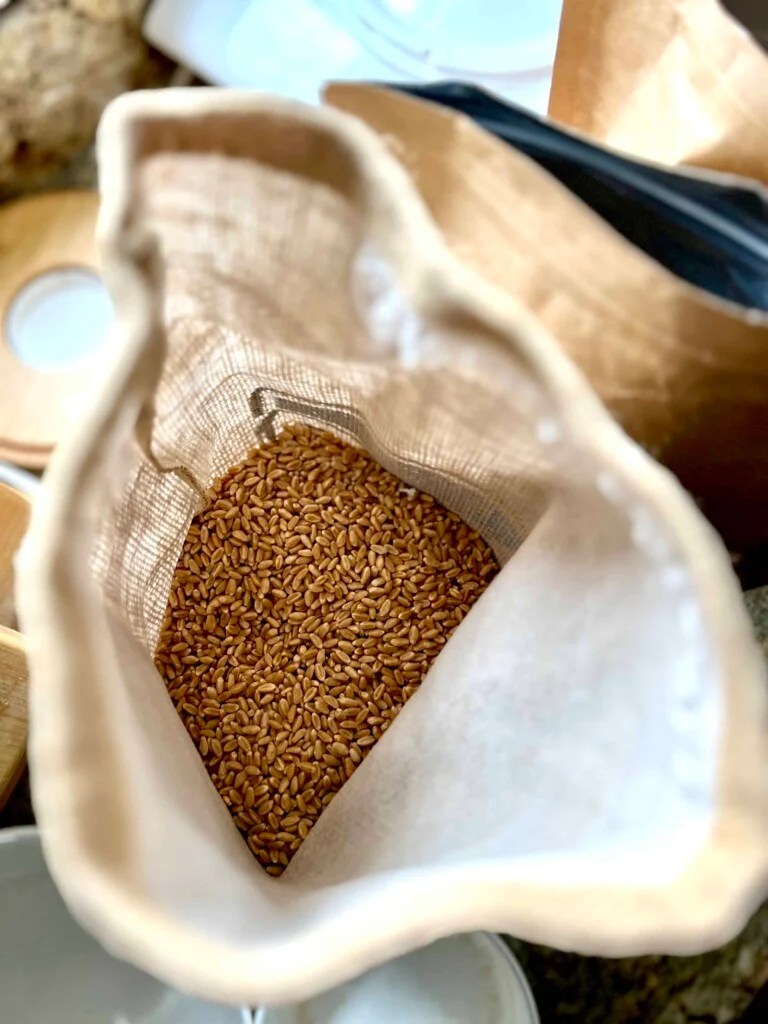


Sourdough Sample Schedule for Whole Wheat Sourdough Sandwich Bread
A sample baking schedule helps me when baking with sourdough. Sourdough takes much longer to rise than commercial yeast bread. This schedule helps me plan my bake.
A few notes: This schedule assumes the dough temperature will be maintained at 78℉ during bulk fermentation and 78-80℉ during proofing. Whole wheat flour tends to move more quickly through the fermentation process, and freshly milled whole wheat moves even more quickly. Watch your dough closely so it doesn’t overproof. If you keep this dough at a lower temperature, it will take the dough a little bit longer to reach each stage.
| Day 1 | |
| 10:00 PM – 7:00 AM | Mix levain. Cover and ferment at 78℉ for 8-10 hours until bubbly, risen, ripe and active. |
| Day 2 | |
| 7:00 AM – 11:00 AM | Knead dough in a stand mixer (or by hand) for 10-15 minutes and begin bulk fermentation, keeping dough at 78℉ |
| 11:00 AM – 6:30 PM | Shape into loaf pan and let rise in a warm place (80℉). The temperature you choose will determine how quickly your loaves will rise. |
| 6:30 PM | Bake: ONLY once the dough has doubled in size and risen above the loaf pan. This will depend on the temperature of your dough. If your dough is kept at 80℉, it will take about 7-8 hours to proof. If you increase the temperature of the dough, it will rise faster. If you decrease the temperature, it will rise much slower. Don’t bake the bread until it has properly risen. |

Some Tips About Using Whole Wheat Flour
Using whole wheat flour in baking provides some challenges and a whole lot of flavor and nutrition. Here are a few tips to keep in mind when using whole wheat flour in this sandwich bread recipe:
- Fermentation will go faster: In general, combining whole wheat flour and sourdough starter is going to speed up fermentation. Using freshly milled whole wheat flour will speed up the fermentation even more. A sandwich loaf that may take 12 hours to rise using bread flour takes 7-8 hours to rise using 100% whole wheat flour (depending on the temperature of course).
- Use freshly milled flour if possible: I much prefer freshly milled flour over an aged whole wheat flour. It tastes better and has more nutrients than a flour that has sat around on a shelf for some time. But, if you have a favorite whole wheat flour you purchase (instead of milling your own), it will work for this recipe too.
- Add in vital wheat gluten: This one simple ingredient makes a huge difference to my 100% whole wheat breads. I find that adding it in this loaf makes the crumb tender, fluffy and much more likely that my children will eat it! Vital wheat gluten is pure gluten that is isolated through washing out the starch and then drying and grinding the gluten that remains. I buy a big bag of it from Amazon and it lasts me a long time since I only add about 10-15 grams per loaf of whole wheat bread.

Mixing a Levain
I like to make a whole wheat levain for this bread to make it almost 100% whole wheat or as close as I can get it without making an entirely separate whole wheat starter.
1:10:10 Levain (ready in 8-10 hours, overnight at 78℉): This recipe calls for a levain mixed the night before. By using whole wheat flour, the fermentation process will go more quickly, so your levain will be ready sooner than if you mix a levain with an all-purpose or bread flour. Keep the levain at 78°F for consistent results. Levain is ready when it has doubled in size, has lots of bubbles, a slightly sour aroma and is just about to start going down from its peak height. Mix together:
- 8 grams of ripe/mature sourdough starter
- 80 grams whole wheat flour
- 80 grams water
If you prefer to mix the levain the day you make the bread, mix a 1:1:1 Levain (ready in 3 – 3.5 hours at 78℉). Mix together:
- 55 grams of ripe/mature starter
- 55 grams of warm water
- 55 grams of whole wheat flour

Mixing the Dough
To the bowl of a stand mixer, add the ripe levain, water, honey, salt, oil, vital wheat gluten and most of the flour. I like to reserve a little of the flour (a little less than 1/2 a cup) and add it in as needed. Knead for 10-15 minutes until dough feels smooth and strong. The dough should pull away from the sides of the bowl or gather all together as it kneads. It will feel tacky to the touch, but should not be overly sticky. If it is very sticky, add a little bit more flour 10-20 grams at a time until it feels tacky and workable. As whole wheat dough sits, it absorbs more water. If the dough feels too dry while you’re kneading, add a little extra water a teaspoon at a time. Whole wheat flour absorbs water at different rates depending on which flour you use, so you may need to make a few adjustments as you knead. This dough can also be kneaded about 10-20 minutes by hand.


Bulk Fermentation
Once the dough is smooth and feels tacky, place it in a bowl or container and cover the dough. Keep it in a warm 78℉ place for about 3.5- 4 hours. Using a see-through container helps you see how much the dough has risen. During the bulk fermentation, expect the dough to puff up, become aerated and begin to rise. Temperature is key to the rise of this dough. If you keep the dough warmer, it will ferment faster. If the dough temperature is cooler, it will take longer to ferment.

Shaping Whole Wheat Sourdough Sandwich Bread
Dump the whole wheat sourdough bread dough out onto a counter. Place a greased 8.5-by-4.5 loaf pan at the top of the dough to guide you on how wide to pat the dough. Pat the dough out with your hands into a rectangle shape, keeping it within the width of the loaf pan. Starting at the edge closest to you, roll the dough up into a log. Take care to press in the dough at the seam after each roll and pinch the seam closed at the end. Pinch and round the ends of the dough just a bit to get a uniform loaf. Place in a greased pan and cover.






Proofing Whole Wheat Sourdough Sandwich Bread
The biggest tip I can give you when making this whole wheat sourdough sandwich bread, is to let this dough rise. It needs to rise about an inch or so above the loaf pan before you bake the bread. If you bake the bread too soon, your bread will be under-proofed and will taste dense and heavy. For best results, really let this bread dough rise. Place your loaf pan in a warm, 80℉ place. If your dough temperature is consistent, this loaf should take about 7-8 hours to rise completely and be ready to bake. Cover the bread dough lightly or use a bread proofer for consistent results. You will know your loaf is ready to bake when it has risen above the loaf pan and when you take a finger and press in on the dough and can observe it spring back just a little bit. If it springs back all the way, it needs more time to rise. Do NOT bake this bread until it has risen above the rim of the loaf pan and feels light and airy.

Baking Whole Wheat Sourdough Sandwich Bread
Pre-heat oven to 350°F. Bake this loaf of whole wheat sourdough bread for 40 minutes. Bread should register 205-210°F when fully cooked. Spread melted butter on the top of the loaf if desired. I like to let the bread cool for about 5-10 minutes in the pan before removing to a wire rack to cool completely. Enjoy!





Frequently Asked Questions
My favorite way to preserve sandwich bread is to slice the loaf after its cooled completely. Then place in a bread bag and store in the freezer for up to a month or two. When you want some bread, toast it or let it thaw completely and enjoy.
In my experience, whole wheat lends itself to a more sour flavor than loaves made with bread flour. The more fermented the dough is, the more sour the flavor. I like to use the levain right after its peak height and watch my fermentation closely so my sandwich bread is not overly sour.
This loaf tastes best with a hard red or white (or combination) of freshly milled flour. For a more mild-flavored loaf, use a hard white wheat flour. For a heartier flavor, use a red wheat flour. I like to combine the two together for great flavor. You can also use grocery store whole wheat flour. Whatever flour you use, make sure it’s one you like because the loaf will take on the flavor of the whole wheat you use. Read more about whole wheat flour varieties here.
It probably needed more water or needed a longer proofing time. Whole wheat flour absorbs more water than a commercially milled flour. It may have needed some extra water based on the type of grain you are using. It’s also possible your loaf needed to proof longer. Make sure you wait to bake the bread until it has risen almost an inch above an 8.5 by 4.5 inch bread pan.



Whole Wheat Sourdough Sandwich Bread
Ingredients
Levain (1:10:10, overnight 8-10 hours)
- 8 grams ripe/active/bubbly sourdough starter
- 80 grams whole wheat flour
- 80 grams water
Whole Wheat Sourdough Sandwich Bread
- 150 grams ripe/active/bubbly levain
- 285 grams water
- 85 grams honey
- 25 grams avocado oil or any neutral flavored oil
- 8 grams salt
- 15 grams vital wheat gluten see recipe notes for substitution
- 500 grams whole wheat flour see recipe notes
Instructions
Mix Levain (1:10:10, overnight 8-10 hours at 76-78°F)
- Make the levain the night before mixing the dough.
- To a small, clear jar, weigh 8 grams of active sourdough starter, 80 grams whole wheat flour (or all-purpose) and 80 grams water. Mix together until a thick batter forms. Cover lightly and set in a warm (76-78°F) place to ferment for about 8-10 hours. The levain is ready when it has risen, almost doubled in size, is bubbly and slightly milky-sweet smelling.
Whole Wheat Sourdough Sandwich Bread
- To the bowl of a stand mixer, add the ripe levain, water, honey, salt, oil, vital wheat gluten and most of the flour. I like to reserve a little of the flour (a little less than 1/2 a cup) and add it in as needed. Knead for 10-15 minutes until dough feels smooth and strong. The dough should pull away from the sides of the bowl or gather all together as it kneads. It will feel tacky to the touch, but should not be overly sticky. If it is very sticky, add a little bit more flour 10-20 grams at a time until it feels tacky and workable. If the dough feels too dry, add a little extra water. Whole wheat flour absorbs water at different rates depending on which flour you use, so you may need to make a few adjustments as you knead. This dough can also be kneaded about 10-20 minutes by hand.
- Bulk Fermentation: Transfer the dough to a see-through container and cover with a kitchen towel. Set the dough in a warm place (78-80°F is optimal) and let rest for about 3-4 hours. The dough will puff up, become aerated and begin to rise during this time.
- Shape: Turn the dough out onto the counter. Place a greased 8.5-by-4.5 loaf pan at the top of the dough to guide you on how wide to pat the dough. Pat the dough out with your hands into a rectangle shape, keeping it within the width of the loaf pan. Starting at the edge closest to you, roll up the dough. Take care to press in the dough at the seam after each roll and pinch the seam closed at the end. Pinch and round the ends of the dough just a bit to get a uniform loaf. Place in a greased loaf pan and cover. You can watch a shaping video here.
- Rise: Let the dough rise in the pan for 7-8 hours until it has risen up over the edge of the loaf pan. The dough temperature should be in the 78°F range for best results. Depending on time of year, temperature and how active your yeast is, the rise could be shorter or much longer. If you notice no change and no rise, put the bread in a warmer place (oven with a light on or bread proofer). Press in gently on the dough with a finger. If the dough springs back immediately, it needs a little more time to rise. If it leaves a little indentation and springs back just a little bit, it is ready to bake.
- Pre-heat oven to 350°F. Bake loaf of bread for 40 minutes. Bread should register 205-210°F when fully done. Spread melted butter on the top of the loaf if desired. Let bread cool for a few minutes in the loaf pan and then remove to a wire rack. Let bread cool completely before slicing and enjoy!


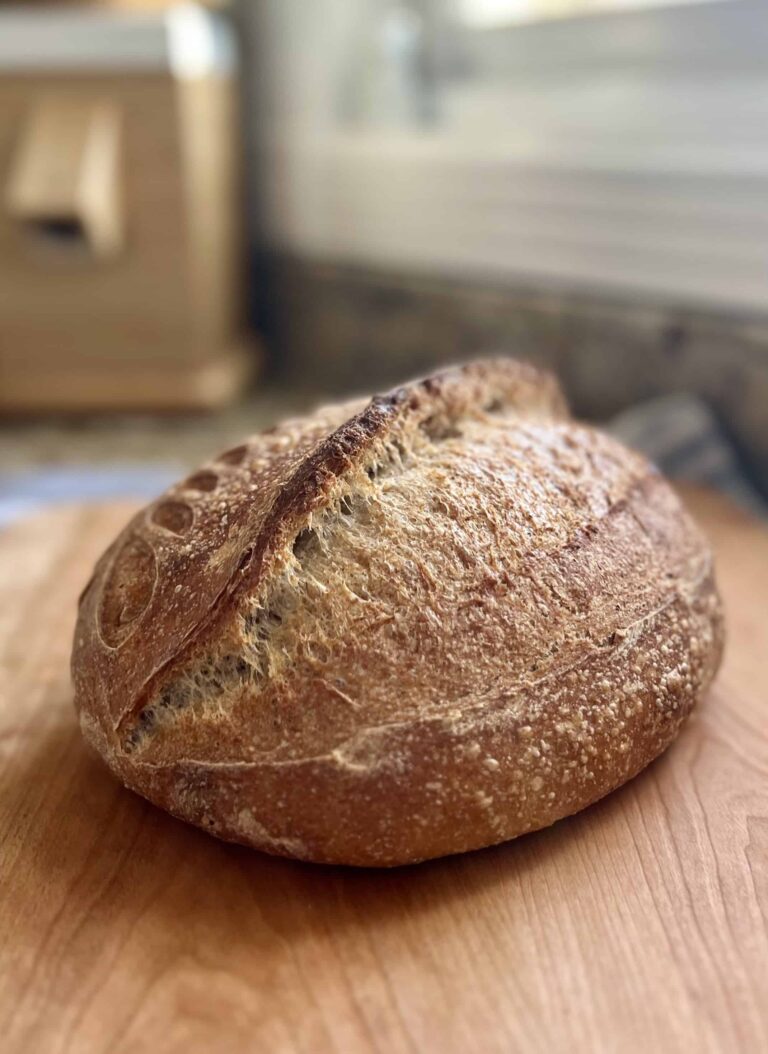
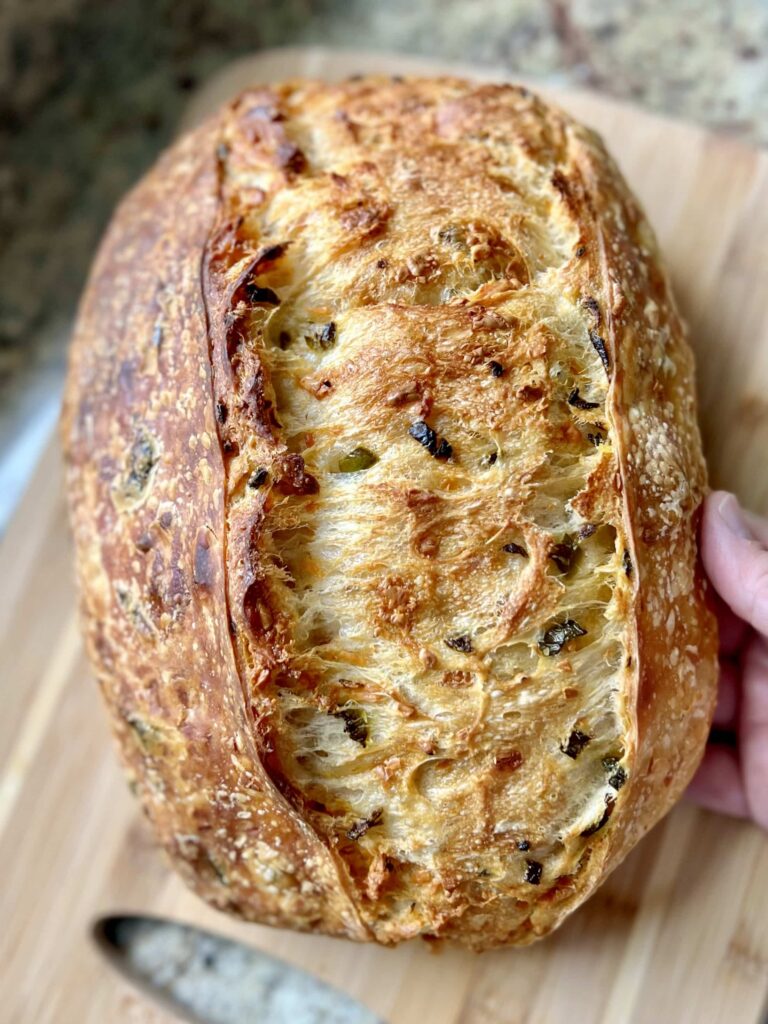
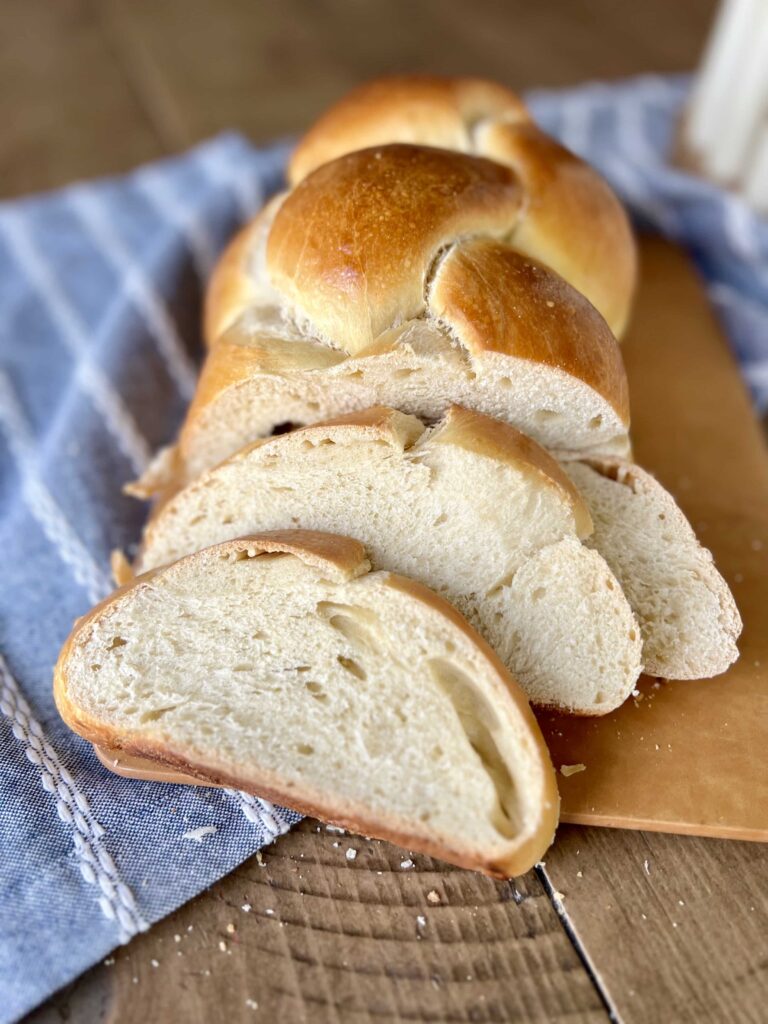
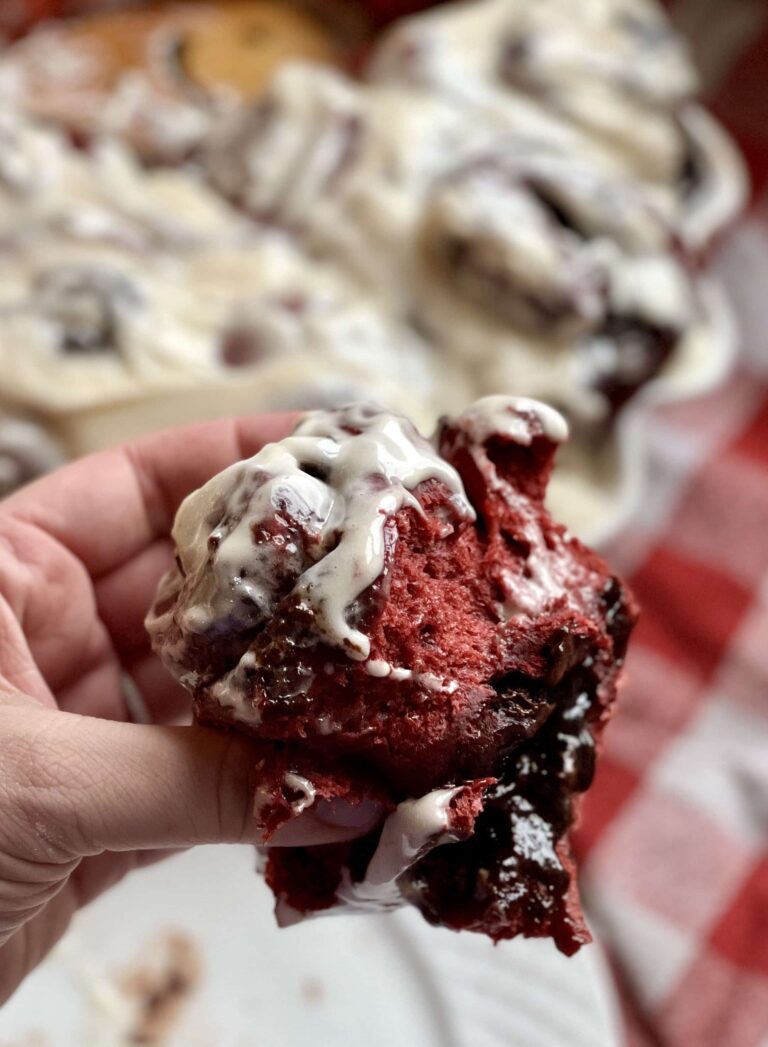

👩🏼🍳🍞😍
Is it only 8g of started for the levain or should that be 80g?
That’s correct. It’s 8 grams if you are making it overnight and going to let it sit for 8-10 hours, keeping it at 78 degrees F. If you want to make a levain more quickly, you can do 55 grams starter, 55 grams whole wheat flour and 55 grams water and let it sit at 78 degrees F for about 3 hours before it’s peaked and ready to use.
Can you proof dough in instant pot and if so for how long compared to regular proofing time?
I haven’t tried that, so I’m not sure. It mainly comes down to temperature though. The warmer the temperature, the faster the dough will proof.
Hi there, earlier on in the post you say to bulk fermentation 3.5-4 hr then proof for 7-8 hrs but in the directions you have proof for 4-6 hrs. Can you clarify please?
I’ll have to fix that. It should be bulk ferment 3.5-4 hours. Then rise around 7-8 hours if the dough is kept around 80 degrees F
Thx! Another question. Can I do the second rise in the fridge while I’m at work for 12 hrs? Then bake so long as it has risen well enough?
I just finished mixing and kneading dough and was placing it in microwave for first rise and realized I forgot to put the honey that I heated up for it !! Do you think that will really kill the texture and end product?
I think it will turn out okay. It won’t have a honey flavor, but shouldn’t have an issue on the texture of the bread.
Turned out great!
Thanks for sharing!
Just wondering if I wanted to substitute brown or even white sugar for the honey, what would I need to change??
I would sub the sugar for the honey and then you’ll want to add a little more flour to the dough to make up for the loss of the honey.
Absolutely delicious! My first time using a levaine, and it turned out perfect.
So glad you loved this one!
This is the best homemade whole wheat bread I’ve ever made. It tastes wonderful and rises better than any recipe using regular yeast.
I’m so glad you loved this bread! Thanks for sharing.